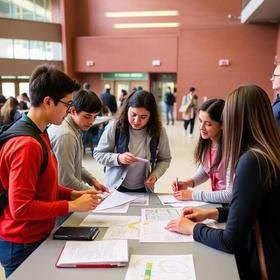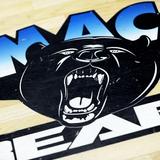- Marshalltown Community College in Marshalltown was founded in 1927 as Marshalltown Junior College, a part of the Marshalltown Community School District. In 1966, MCC moved under the jurisdiction of Iowa Valley Community College District, where it continues to serve the needs of Marshall County and the surrounding area. In 1993 the District opened a satellite center in Poweshiek County, now known as Iowa Valley Grinnell, which offers MCC college credit courses and continuing education to students in that geographic area.
School Highlights
Marshalltown Community College serves 2,088 students (37% of students are full-time).
The college's student-teacher ratio of 14:1 is lower than the state community college average of 17:1.
Minority enrollment is 42% of the student body (majority Hispanic), which is more than the state average of 32%.
Quick Facts (2025-26)
- Enrollment: 2,088 students
- In-state tuition: $4,296
- Out-state tuition: $4,536
- Student-teacher ratio: 14:1
- Minority enrollment: 42%
- Source: Integrated Postsecondary Education Data System (IPEDS)
Top Rankings
Marshalltown Community College ranks among the top 20% of public schools in Iowa for:
School Overview
The teacher population of 154 teachers has stayed relatively flat over five years.
Marshalltown Community College
(IA) Community College Avg.
Carnegie Classification
Associate's Colleges: Mixed Transfer/Career & Technical-High Nontraditional
Not applicable, not in Carnegie universe (not accredited or nondegree-granting)
Institution Level
Less than 2 yrs
At least 2 but less than 4 years
Institution Control
Public
Private not-for-profit
Total Faculty
154 staff
274 staff
School Calendar
Student Body
The student population of Marshalltown Community College has grown by 7% over five years.
The student-teacher ratio of 14:1 has increased from 12:1 over five years.
The Marshalltown Community College diversity score of 0.60 is more than the state average of 0.52. The school's diversity has declined by 15% over five years.
Total Enrollment
2,088 students
2,140 students
Student-Teacher Ratio
14:1
17:1
# Full-Time Students
769 students
148 students
# Part-Time Students
1,319 students
1,992 students
# Enrollment Undergraduate
208 students
333 students
# Full-Time Undergraduate Students
769 students
148 students
# Full-Time Graduate Students
n/a
61 students
# Part-Time Undergraduate Students
n/a
2,075 students
# Part-Time Graduate Students
n/a
403 students
Total Dormitory Capacity
n/a
400 students
% American Indian/Alaskan
1%
n/a
% Asian
3%
3%
% Hispanic
23%
9%
% Black
2%
7%
% White
58%
68%
% Hawaiian
n/a
1%
% Two or more races
2%
3%
% Non Resident races
4%
1%
% Unknown races
7%
8%
Diversity Score
0.60
0.52
College Completion Rate (Students who graduate in less than 4 years)
35%
51%
College Completion Rate (Students who graduate in 4 years or more than 4 years)
n/a
26%
Average Graduate Earnings (10 Years)
$33,000
$33,600
Tuition and Acceptance Rate
The public in-state tuition of $4,296 is less than the state average of $4,331. The in-state tuition has declined by 13% over four years.
The public out-state tuition of $4,536 is less than the state average of $4,920. The out-state tuition has declined by 14% over four years.
In-State Tuition Fees
$4,296
$4,331
Out-State Tuition Fees
$4,536
$4,920
Tuition Notes
$1,300/semester
% Students Receiving Some Financial Aid
86%
93%
Median Debt for Graduates
$10,319
$11,250
Median Debt for Dropouts
$5,032
$5,500
Acceptance Rate
n/a
72%
ACT Composite
n/a
22
ACT English
n/a
22
ACT Math
n/a
21
Source: 2024 (or latest year available) Integrated Postsecondary Education Data System (IPEDS) , School Administrators
School Notes
- We help our students move quickly into a skilled career with over 52 Career-Technical diploma, certificate, and two-year associate degree programs designed to prepare them to hit the workforce with an edge. Equipped with an associate's degree, you can enjoy an average lifetime earning of $250,000 more than someone with less formal education. Our 43 Associate of Arts and Science Transfer programs prepare our students for four-year institutions with the first two years of general education and program prerequisites under their belt. Our graduates that finish these degrees can earn from $300,000 to over a million dollars more over their lifetime than their neighbors with less formal education. The MCC Library is a place for resources and information, as well as a popular place to study. Students can check out books and periodicals with their student ID's, use the copy machine, surf the Internet, use the computers, look at college catalogs, research class projects, and borrow audio-visual equipment.
Frequently Asked Questions
How much does Marshalltown Community College cost?
Marshalltown Community College's tuition is approximately $4,296 for In-State students and $4,536 for Out-State students.
What is Marshalltown Community College's ranking?
Marshalltown Community College ranks among the top 20% of community college in Iowa for: Least expensive tuition and Diversity in US community colleges.
Recent Articles

Community College Success Rates 2025: Outcomes & Trends
Updated 2025 analysis of community college success rates, completion, transfer, costs, enrollment, and strategies that shape student outcomes.

Community Colleges in 2025: Combating Stereotypes with Impact
Updated insights on how community colleges are dispelling myths, growing enrollment, and expanding pathways in 2025.

2025 FAFSA Changes Explained for Community College Students
A comprehensive guide to 2025 FAFSA changes, what community college students must know, new eligibility rules, timelines, and tips to maximize federal aid.










